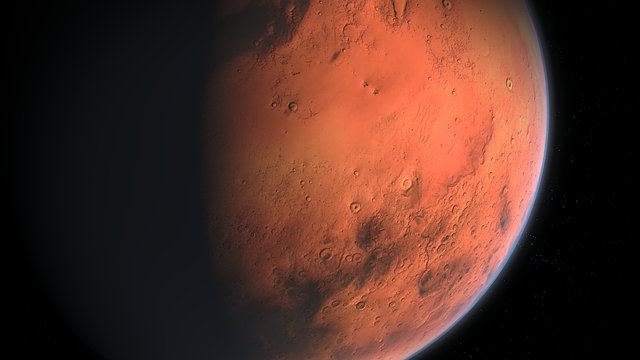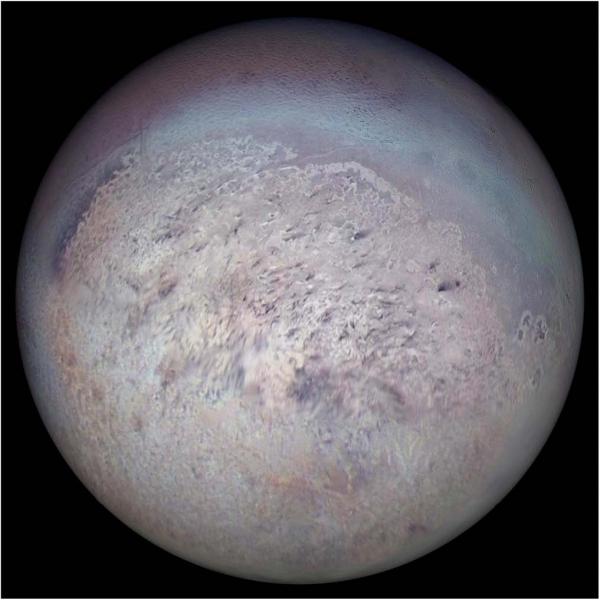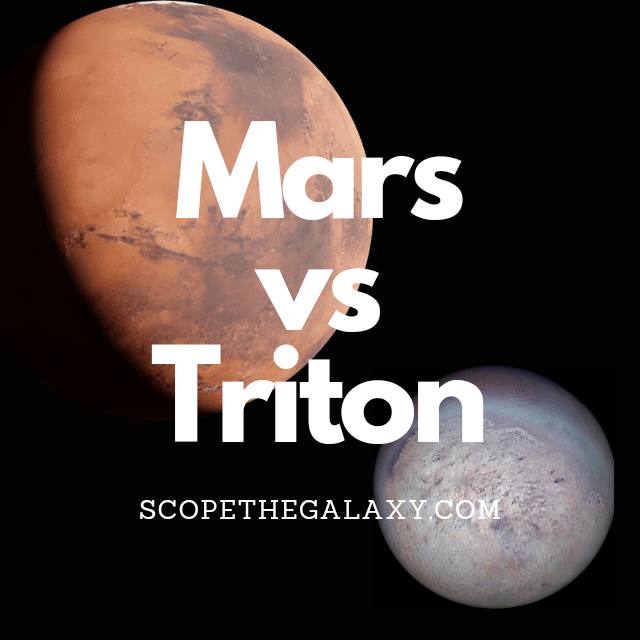*This post may contain affiliate links. This means we may make a commission if you purchase an item using one of our links*
The main differences between Mars and Triton is that Mars is a planet with 2 moons whilst Triton is one of Neptune’s moons, Mars is bigger with a diameter of 6,779km whilst Triton has a diameter of 2,706km and Triton is far colder with a temperature of -235 °C whilst Mars has an average temperature of -65°C.
There are various other differences between the two so continue reading for a more detailed breakdown on Mars and Triton along with their similarities and differences below.
What Is The Planet Mars?
Table of Contents

Mars, also known as the red planet, is the celestial object that’s the front runner in our entire solar system to become a possible new home for us if terraformed. It is also the 4th farthest planet from the Sun and is one of 4 main line terrestrial planets (not including Pluto) in our solar system.
This means that one year on Mars will take roughly 687 Earth days and a day on Mars is roughly the same as Earth at 24 hours and 37 minutes. It’s axial tilt is also very similar to that of Earth where it is positioned around 25 degrees to the right.
It may not be the largest terrestrial world in our solar system as its diameter is only 6,779km but, it does have the most moons amongst the normal terrestrial planet where two, namely Deimos and Phobos, are currently orbiting the red planet.
Like Earth and the other terrestrial worlds, Mars does have an atmosphere, certainly more visible than that on Mercury but, when compared to Earth’s it is merely 1% of its volume.
As a result it is more susceptible to larger debris striking its surface and is unable to trap in too much heat either. This is why it’s on the colder side with a temperature of around -65 degrees Celsius on average. On the contrary its core is significantly hotter at 1,350 degrees Celsius.
Mars is probably the most explored planet outside of our own, with a multitude of rovers like Sojourner (1997–1997), Opportunity (2004–2018), Spirit (2004–2010), Curiosity (2012–), and Perseverance (2021–) that have landed on the Martian soil to explore it.
Billionaires like Elon Musk and even Jeff Bezos are trying for an opportunity to genuinely have astronauts land on the Martian soil, possibly as early as 2029 so, Mars clearly has a lot interested in its terrain, as a potential substitute for Earth in the future.
What Is The Moon Triton?

Triton is the largest moon of Neptune, whose most unusual feature is its retrograde orbit. Triton is the only major moon in our solar system which orbits in the opposite direction of its planet’s rotation.
First discovered on 10th October 1846 (just 17 days after the discovery of its planet, Neptune) by British astronomer William Lassell, “Triton” comes from a merman in Greek myth; a name which perhaps stems from the composition of this faraway moon.
The diameter of Triton is approximately 2,706km, making it a similar size to Earth’s moon. However, we know that its mass is far less than the first estimates suggested because data from Voyager showed that the surface is icy and highly reflective, a less dense composition than the dark surface of our moon.
This icy surface has resulted in ice based natural satellite displaying temperatures in the region of – 235 degrees Celsius.
This lower density stems predominantly from the water-ice interior encasing a denser rock core. Still, the mean density of 2.06 grams per cubic cm remains higher than that of any of Saturn’s or Uranus’ moons. In addition, Triton holds more than 99.5% of the mass of everything that orbits the planet Neptune and its total mass is greater than every smaller satellite in the solar system combined.
Scientists think that Triton may be an object from the Kuiper Belt that Neptune’s gravity captured millions of years ago. This is because it shares many similarities with the dwarf planet Pluto – the best-known world within the Kuiper Belt.
This frozen world is a land of geological oddities with craters and a collection of depressions and ridges known as cantaloupe terrain. The geysers found on this moon shoot plumes of nitrogen as high as 8km high, which creates a thin atmosphere of nitrogen.
In around 3.5 billion years, Triton’s orbit will travel too close to Neptune, and the planet’s gravitational pull will break the moon apart, creating a ring system.
Similarities Between Mars And Triton
Triton and Mars do have their odd few similarities, which in this case includes the below:
- Both have a hotter central core.
- Both have an atmosphere and a rocky surface.
- Both are a spherical shape.
- Both are part of the same solar system.
- Both have no rings surrounding them.
- Neither have tectonic plate activity.
Differences Between Mars And Triton
As for the differences between the two, they include the below:
- Triton orbits Neptune whilst Mars only orbits the Sun.
- Mars has 2 moons whilst Triton has 0.
- Mars has a diameter of 6,779km whilst Triton’s diameter is 2,706km.
- Triton has a very thin exosphere composed mostly of nitrogen with small amounts of methane whilst Mars’ atmosphere is 1% of Earth’s thickness composed mostly of 95% carbon dioxide 2.6% nitrogen and 1.9% argon.
- A day on Triton takes 5.877 days whilst a Mars day is 24 hours 37 minutes.
- It takes Triton 5.877 days to orbit Neptune and around the Sun in 165 years whilst Mars orbits the Sun in 687 days.
- Mars has an axial tilt of 25 degrees whilst Triton’s axial tilt is close to 0.
- Triton’s average temperature is around -235 degrees Celsius whilst Mars has an average temperature of – 65 degrees Celsius.
- Mars’ density is 3.93 g/cm³ whilst Triton’s density is 2.06 g/cm³.
- Mars’ mass is 6.39 × 10^23 kg whilst Triton’s mass is 2.14 × 10^22 kg.
- Triton’s gravitational strength is 0.779 m/s² whilst Mars’ is 3.721 m/s².
- Triton is the only moon in our solar system that orbits its planet in a retrograde orbit whilst Mars orbits the Sun in a counterclockwise direction as most of the other celestial objects in our solar system.
- Triton is tidally locked to Neptune whilst Mars is not tidally locked to any entity.
Summary
Although Mars and Triton are part of the same solar system and have a similar terrestrial composition, the two are still very easily distinguishable.
Whether it be in regards to mass, size, magnetic fields, atmospheric composition, temperatures and more, the two are still very different despite the common features they share.

